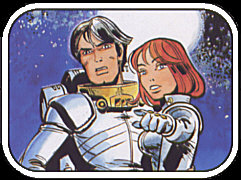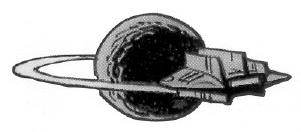

ARTICLE
|
Valerian, the new futur trilogy (foreword) Kim Thomson
 A time-hopping special-agent-slash-galactic-cop who, under the aegis of a group of more or less benevolent leaders from the timeless (albeit technically located in the 28th century) enclave of Galaxity, solves crises from all eras, accompanied by Laureline, a plucky and beautiful 11 th century woman he'd picked up in his first adventure : There you have, in a nutshell, Pierre Christin and Jean-Claude Mézières's Valerian. But this summary hardly does justice to what is arguably the greatest science fiction comics séries ever created. Stunningly and inventively drawn and with witty, intricate, literate scripts, Valerian was (and remains) one of the pillars of the 1960s' « second wave » of classic Franco-Belgian comics. Centered around the fledgling Pilote magazine (founded in 1959) under the enlightened leadership of René Goscinny, this new generation of cartoonists spent that tumultuous decade blowing the dust off the mostly Tintin-derived comics that had dominated the market, offering more sharply satirical visions (such as Pilote's figurehead success, Goscinny and Albert Uderzo's Asterix) ; more vigorously « adult » adventure séries (including the classic western Blueberry, illustrated by Mézières's friend Jean Giraud-who would later make his own mark on the science fiction genre under the name « Moebius ») ; and a much wider and bolder range of graphie styles. Valerian, whose earliest exploits began running in Pilote in 1967, managed to incorporate all of these progressive elements : Christin's approach to adventure provided a wry, satirical edge, while Mézières rendered violence (and a little bit of sex — the spunky, sultry Laureline, half working companion and half romantic interest, would have been unthinkable just a decade earlier) in a loose, elegantly abstracted style that found a near-miraculous balance between realism and cartooniness not seen since Roy Crane's Wash Tubbs (1924-1943). American comics readers have already had a few chances to enjoy Valerian's adventures. Heavy Metal broke the ice by serializing the 7th album, Ambassador of the Shadows, in 1981. Shortly thereafter, Pilote's ill-fated American venture Dargaud USA collected Ambassador and released three additional stories in album format : World Without Stars (Vol. 4), Welcome to Alflolol (Vol. 5), and the super-hero satire Heroes of the Equinox (Vol. 10). In 1996, the short-lived Fantasy Flight Publishing re-released Heroes of the Equinox, this time as two comic books-and there the matter rested. Until now. The volume you're holding in your hands represents ibooks' smart, bold, and ambitious attempt to marry the appeal of the European « graphic album » with that of the American « graphic novel » by combining three Valerian stories into one big book. And, in fact, these choices are very shrewdly made, because the triptych of albums collected herein (Volumes 14 through 16, if you're keeping count)-On the Frontiers (1988), The Living Weapons (1990) and The Circles of Power (1994)-begin a major new « phase » in the Valerian séries. Now, if you've started reading these stories before checking out this introduction, you may have noticed that the premise of the series appears to no longer be in effect. And thereby hangs a tale . . . In the preceding volume, Christin and Mezieres had unexpectedly turned the series on its head by obliterating Valerian and Laureline's home base, Galaxity. As a result, the former « spatio-temporal agents » have now become freelancers, eking out their subsistence as troubleshooters or mercenaries-a new situation that (especially in The Living Weapons) brings on its own set of ethical conundrums. The three stories collected herein happen to offer a perfect summary of the three recurring types of classic science-fiction milieux that predominate in Valerian : Modern-day Earth ; a rough, primitive planet ; and a classic ultramodern science-fiction urban milieu. A note about that last one. Those who remember the 1997 Luc Besson film The Fifth Element may find Mézières's depiction of this future city a bit... familiar, especially those flying cabs. This is neither tribute, theft, or coïncidence. In the early 1990s, Besson had enlisted Mézières to help design the environment for a science-fiction epic he intended to be his next film, in which the protagonist would be a worker in a rocketship factory. Mézières took a year off from Valerian (he had been working on The Circles of Power) and created a panoply of designs. As the film dropped into development hell (Besson went on to do The Professional instead), Mézières and Christin finished their album, published it in 1994 and sent it to Besson-who, enamored of the flying cabs, transformed the hero of his movie into a cabdriver. Mézières subsequently spent several more months on designs, resulting in one of the most visually stunning science-fiction movies ever made. This was not Valerian's first brush with the world of cinéma. In 1977 Mézières sat down in a movie theater to enjoy a new movie called Star Wars and was astonished to see how many of the designs and concepts — and, indeed, the whole motif of a lived-in, funky future- seemed awfully familiar. Polite inquiries to the Lucas camp went unanswered, but over the years word leaked back that the Star Wars designers (some of them French) had indeed maintained a nice collection of Valerian albums. Adding insult to injury, the subsequent The Empire Strikes Back included a scene of Han Solo being encased in molten plastic, an exact duplicate of a sequence from the 1971 Empire des Mille Planètes (The Empire of a Thousand Planets). A decade and a half later, those LucasFilm designers were apparently undeterred : Compare the Shingouz-those diminutive, bewinged, long-snouted, ethically-impaired traders who first appeared Ambassador of the Shadows and can be seen here toward the end of On the Frontiers-with Watto, the diminutive, bewinged, long-snouted, ethically-impaired trader in whose thrall Anakin Skywalker is found in the 1999 The Phantom Menace. Hmmmm . . . Although no lawsuits were ever filed, karma has a way of working things out : As the increasingly unwatchable and self-indulgent Star Wars movies spiral into irrelevance with each new installment, Valerian maintains its position as a genuine classic of science fiction (Mézières and Christin are currently working on the 20th album). A perfect future, available again for your pleasure today.
Kim Thompson
|









